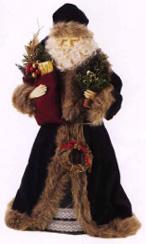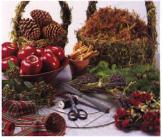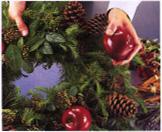In The Royal Manner (23 page)

I have chosen a Victorian theme for my Christmas menu, as it was the Victorians who established most of the traditions that we are familiar with today. Whatever your taste, the following chapter will, I hope, provide you with the inspiration to make this coming Christmas and New Year an enjoyable and truly memorable one.
THE MAGIC OF CHRISTMAS
Christmas is a combination of festivals and traditions which can be traced back to the Roman invasion of Britain, when they bought with them their teachings of Christianity. Aspects of Pagan festivals and Druid traditions have all been absorbed into our Christmas culture. For example, Juul, a Viking winter festival in honour of their God, Odin, is where the word ‘Yule’ originates, and Pagan rituals included decking houses with greenery to give a safe haven for winter spirits. The Romans decorated their homes with swags of holly to celebrate the New Year, and the Anglo-Saxons incorporated mistletoe into their decorations, believing that it protected their homes against witchcraft.
The tradition of Father Christmas was introduced to us by our American cousins. St Nicholas was a bishop in Asia Minor and he was particularly kind to children and showed great interest in their welfare. According to legend, he threw three bags of gold through the window of o poor family and each bag fell into a stocking of the young girls within as they were hung up to dry over the fireplace.


Thus the tradition of Christmas stockings was adopted by the early Dutch settlers who founded New York. The ideals of ‘Sinter Klaas’ who became Santa Claus have since melted into our culture and are now commonplace.
The giving of presents on Christmas Eve was a tradition that began in Victorian times and, by the end of the 19th century, Christmas was almost as traditional as it is today. Previously, presents were exchanged on St Nicholas’ Day (6 December) or at the New Year. The Royal Family open their presents after tea on Christmas Eve. Christmas stockings are, however, reserved for Christmas morning and are still filled by members of the Royal Family for their children.
A CHRISTMAS WREATH FOR YOUR DOOR
What could provide a more festive welcome than this natural Christmas decoration to greet your friends and family as they enter your home? The beauty of this design is that it con also be used as the basis for a table decoration - simply place on a board and fill the centre with three ivory candles of varying heights. Before you begin to assemble the Christmas wreath, map out on a piece of paper exactly where each item is to be placed. Arrange decorative items in groups of 3s, 5s and 7s, and don't be afraid to put things in pairs - this can only enhance the visual impact. Once Christmas is over you can put the wreath out in the garden for the birds to eat.
Step 1
1 carrier bag full of sphagnum moss
23cm/9in wire ring (available from florists)
1 spool of reel wire
Small branches of larch fern or other evergreen
Small stems of viburnum or ivy
A few lengths of stub wire
5 large fir cones
5 red apples
5 bundles of dried lavender
3 bundles of dried red roses
5 bundles of cinnamon sticks
Approx. 4m/12 feet length of wide tartan ribbon
Step 2
Pack small bunches of moss firmly into the ring. At the same time, wind round the reel wire to hold the moss in place. Trim the moss neatly using a pair of scissors.
Step 3
To attach the fern to the moss ring, bunch pieces of fern and viburnum (or ivy) together at angles, then carefully attach to the moss ring by winding the reel wire around each bundle. Continue until the fern is completely covering the ring of moss.
Step 4
Attach the trimmings to the ring using short lengths of stub wire. Wind a piece round the base of each fir cone and twist, making sure there is sufficient wire left on each side to wrap around the ring. Skewer the apples with the wire, through their base, and twist the ends of the wire together. Wire up the small bundles of lavender, cinnamon and dried roses. Secure the fir cones to the ring, followed by the apples and finally the small wired-up bundles.
Step 5
To complete the wreath, wind some stub wire through the top back part of the wreath and twist the ends together to form a hook. At the opposite end, tie the ribbon round in a large bow, and allow the ends to drape down
5.

1.

2.

3.

4.

Christmas would not be complete without a turkey or Christmas pudding. Turkeys are indigenous to North America, and the Pilgrim Fathers served turkey at their inaugural Thanksgiving Day service in 1621. The turkey has largely replaced the Victorian tradition of roast goose. Working-class Victorians would pay into a ‘goose club’, usually run by the local publican on a weekly basis. By the end of the year enough money would have been saved to provide the family with a plump goose for Christmas lunch. I have decided to restore the tradition with a delicious recipe for roast goose as part of my interpretation of a traditional Christmas menu.
ROSEMARY BREAD CASES
WITH
FENNEL
AND
EGG FRICASSEE
This particular favourite is an ideal first course for any occasion but especially at Christmas. Rosemary bread is an excellent and tasty alternative and complements the light egg fricassee.
Serves: 8
Preparation time: 20 minutes
Cooking time: approx. 33 minutes
8 large thin slices white bread
175g/60z butter
2 tbsp freshly chopped rosemary or 2 tsp dried
3 medium eggs
1 small bulb fennel
2 tbsp single cream
2 plum tomatoes, skinned, seeded and finely diced
Fresh rosemary to garnish
Preheat the oven to 200° C/400° F/Gas 6
1.
Remove the crusts from the bread, and roll each slice lightly with a rolling pin to flatten slightly.
2.
Melt 100g/4oz butter and lightly brush some into 8 deep muffin tins. Add the chopped rosemary to the remaining melted butter.
3.
Press a bread slice into each tin and then brush generously with the rosemary butter. Season and bake in the oven for 10 minutes. Stand for 10 minutes, then remove from the tins, place on a baking tray and cook for a further 5–6 minutes until golden and crisp. Keep warm.
4.
Place the eggs in a saucepan and cover with water. Bring to a boil and cook for 8 minutes. Drain well and cool under cold running water. Then peel and chop.
5.
Trim and reserve any fronds from the fennel. Discard any damaged outer layers, and then finery slice the white flesh.
